[ad_1]
Are you struggling with WordPress local SEO and getting your site noticed in local searches?
SEO can be tricky, and local SEO has its own set of challenges. But here’s the good news: we’ve been helping small business owners win at SEO for years. We know what it takes to rank in the search results and get more traffic to your website.
Local SEO is more than just using the right keywords. It’s about attracting potential customers who live right around the corner.
In this article, we will show you the ultimate WordPress local SEO guide to get your website noticed by your local customers.
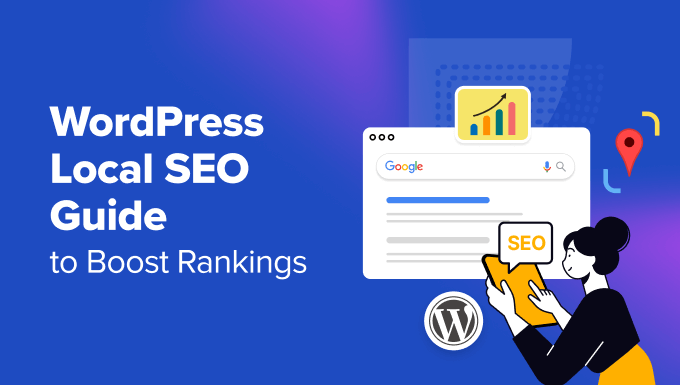
What Is Local SEO?
Local SEO is a type of search engine optimization (SEO) that helps local businesses get found by users searching online.
For example, if you run a pizza place in your area, then local SEO can make your business appear at the top of relevant search engine results pages (SERPs).
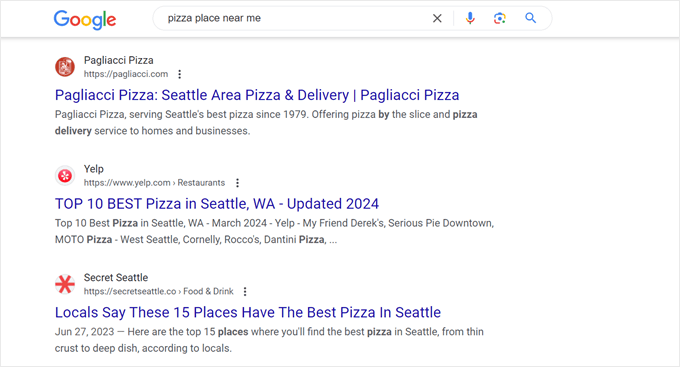
Search engines use algorithms to understand a user’s location and offer relevant local search results. They look at the person’s IP address, the search query, and business listings to associate businesses with specific locations.
With this information, search engines can then show results that are most relevant to the person’s location and needs.
Optimizing your online presence for local searches can help you drive more organic traffic and attract potential customers in your area. This is why local SEO is an important digital marketing strategy for small businesses.
What Are Local SEO Ranking Factors?
Local SEO ranking factors are what search engines look at when they are deciding which local businesses should appear at the top of search results.
Here are some key factors that influence local rankings:
Google Business listing – This free Google tool allows businesses to manage their online presence across Search and Maps. Having your company listed here will make it easier for users to find you.
Reviews – Comments from customers are like social proof. They can influence local search rankings because they show potential buyers that other people have had a good experience with your business.
Relevance to search query – This means making sure your business information and content match the searcher’s keywords.
NAP consistency – Short for Name, Address, and Phone number, it’s important that these details are consistent across all your online platforms to avoid confusion.
Proximity to the searcher – This refers to how close your business is to the person doing the search. Search engines often rank businesses closer to the searcher.
Other standard search ranking factors, such as website performance, high-quality content, and user experience, can also affect where your web pages rank on search engine results pages.
Now, let’s look at some of the best WordPress SEO practices to rank for local searches. You can use the quick links below to navigate through our tutorial:
1. Create a Google Business Profile
A Google Business Profile, also known as Google My Business, is a free and powerful tool that can help your business appear in local organic searches.
It acts like a digital storefront that appears on Google Maps and Search results when people look for businesses like yours in their area.
Here’s an example:

By claiming and optimizing your Google Business Profile, you can provide potential customers with key information about your business, like your address, phone number, WordPress website, and opening hours.
To create a Google Business profile, head over to https://www.google.com/business/ and click ‘Manage now.’ Then, sign in with your Google account.
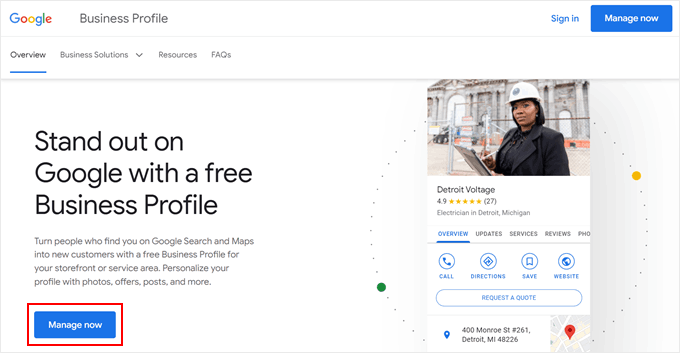
Once signed in, you can start by entering your business name. Google will then search for existing listings.
If yours doesn’t appear, then you can select ‘Create a business with this name’ to continue.

The next step is to choose one of these business types: online retail, local store, or service business. The onboarding steps for each business type may look a bit different from one another.
Once you have made your choice, click ‘Next’.

If you picked ‘online retail’ in the previous step, then you will now enter the web address of your online store.
You can skip this step if you have not made an eCommerce site yet.
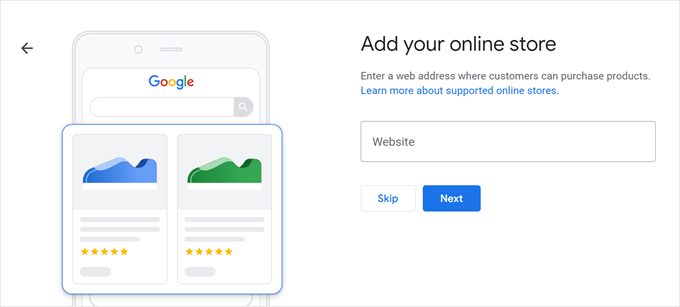
Now, it’s time to choose a business category. Simply type in what type of product or service you offer in the field, and some options will start appearing.
Then, click ‘Next’.
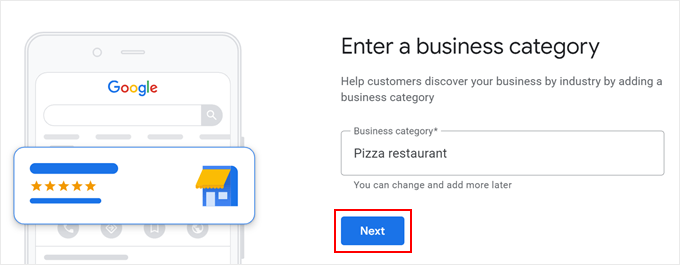
At this stage, you can enter your business address.
To complete this step, fill out your country/region, street address, city, state/province, and zip code. Then, hit the ‘Next’ button.
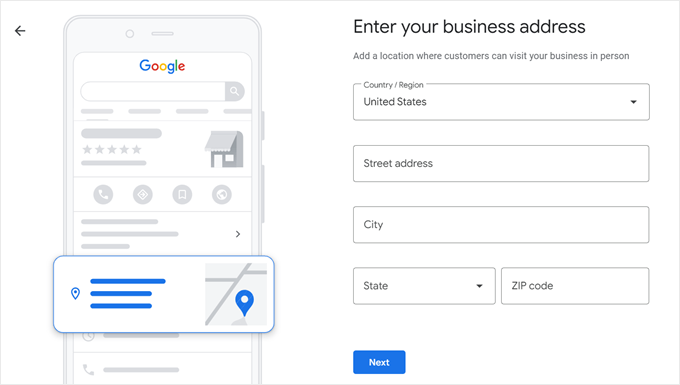
Based on the address you enter, Google may suggest some business listings that are already in their directory but have yet to be claimed.
If you don’t see any listings related to your business, select ‘None of these’ and continue to the next step.
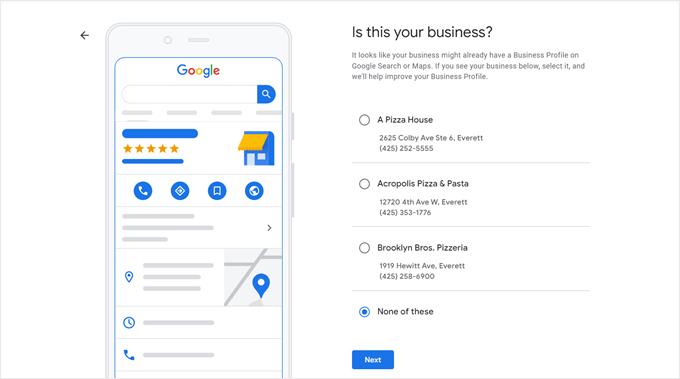
Now, a map will appear. Here, you will have to drag the pin onto your business location. This will help users find your business with Google Maps.
Once done, click ‘Next.’
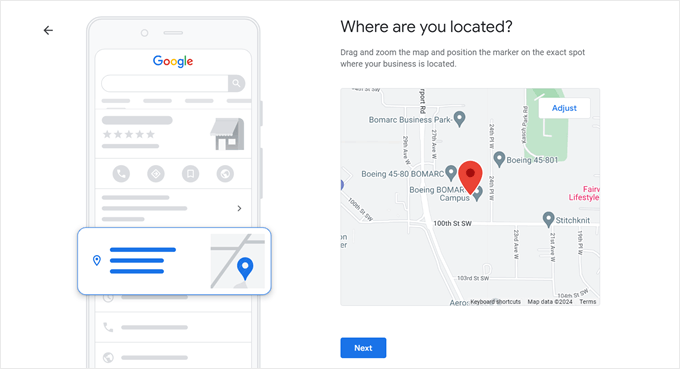
The next step is to enter your contact phone number.
If you don’t have one yet, then just skip this step. You can also read our expert pick of the best business phone services if you need some recommendations.

You have now successfully created a business listing on Google.
To go ahead with updating your business details, click ‘Continue’ on the screen below.

First, you must verify that you actually own and manage the business. Google automatically determines the verification method based on the business information you’ve provided so far.
If you want to verify your business at another time, just click ‘Verify Later.’

Now, depending on your business type and category, you will have to enter additional information in the next onboarding steps.
For example, if you run a restaurant, then you will have to specify your business hours and dining modes and add photos of your establishment.
Once you have completed all that information, you will see an option to claim a $500 Google Ads credit. With this, you can advertise your business so that it appears at the very top of local searches (above organic search results).

You will also see an option to sign up for Google Workspace, which is a software kit that includes professional Google Mail, Drive, Calendar, and other Google products.
With this, you can create a professional business email address with a custom domain name.
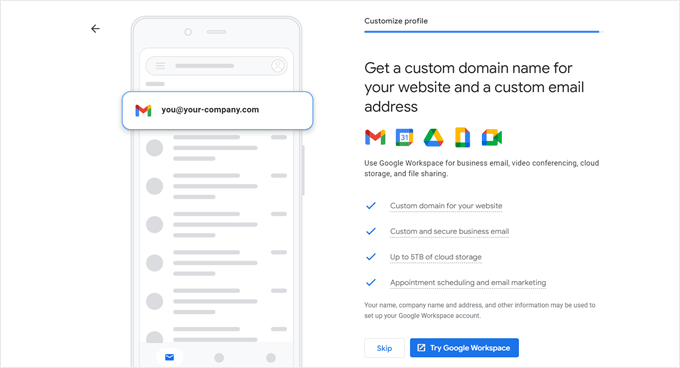
And that’s it. If you decide to verify your business right away, then Google will review your business profile integrity within 7 days of your verification. After that, your business listing will be visible on Google.
Pro Tip: Besides Google Maps, Apple Maps is another popular mapping platform people use to find local businesses. Our guide on how to optimize your site’s SEO for DuckDuckGo includes a handy tutorial on how to add your business to Apple Maps.
2. Install a WordPress SEO Plugin With Local SEO Features
Having a Google Business Profile is a great first step, but it’s not the only tool in your local SEO toolbox. A WordPress plugin with local SEO features can also help your website rank better in Google search results.
While Google My Business focuses on your business listing, SEO tools and plugins can help optimize your website content for local searches.
Many plugins offer features specifically designed to improve your local ranking, like adding schema markup to your website. Also called structured data, schema markup gives search engines more information about your business in a clear and organized way.
By adding schema markup, you are not just helping search engines crawl, index, and rank your website. You are also making the information about your business in search results clearer and more interesting.
This can make your website stand out more in search results, which can improve your website’s click-through rates.
Here’s an example of a snippet you may find when looking for ‘Joe’s pizza NYC’:

There are many SEO plugins for WordPress websites, but our favorite is All in One SEO (AIOSEO).
This WordPress plugin makes it easy to set up your local business schema without using code.

For more information about using AIOSEO’s local SEO features, you can read our guides below:
3. Add Google Maps to Your WordPress Site
Besides setting up your local business schema, you can also use AIOSEO to add your business’s Google Maps listing to your WordPress site.
This doesn’t mean that adding Google Maps to your website will suddenly put your site at the top of search results. But it can increase your chances significantly in a few ways:
Local SEO signals – Embedding a Google Map on your website strengthens local SEO signals to search engines. It tells search engines your business has a physical location, which is crucial for local searches.
User experience – Having a map on your website improves the user experience by allowing people to easily see your location and plan their visit. This can keep visitors engaged on your site for longer.
Social proof – Google Maps reviews can serve as social proof, showing potential customers that others have had positive experiences with your business. This can increase trust and encourage more people to visit your website.
You can read our article on how to add a Google Maps store locator to WordPress for more information.
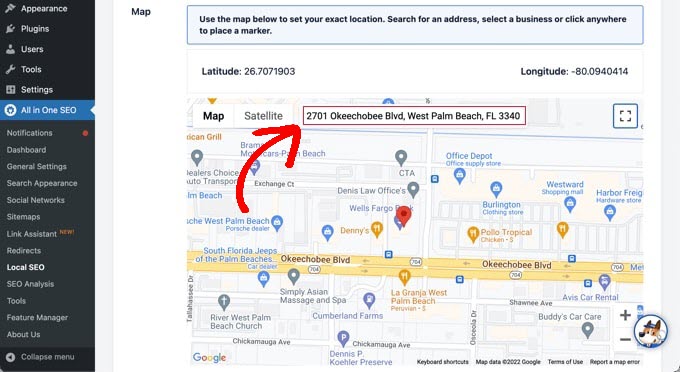
Alternatively, you can check out our guide on how to embed a Google Map in a contact form. This tutorial can be useful if you want to include the map in your contact information page.
Additionally, you could also create an interactive map on your WordPress website or landing page. This will help users plan their travel to your physical address.
4. Do Local Keyword Research
Before you jump into creating content, it’s essential to understand what people in your area are actually searching for online. Local keyword research is an important SEO strategy that can help you achieve this.
Unlike regular keyword research that focuses on global search terms, local SEO targets specific keywords with a local focus, like ‘best pizza near me’ or ‘pizza delivery [your city].’
To get started with local keyword research, you don’t need to be an expert. There are many keyword research tools available, like WPBeginner’s Keyword Generator Tool.
All you need to do is enter a keyword, like your business category and your location. After that, the tool will come up with keyword ideas that you can include in your content later. Here’s an example using ‘pet sitters Seattle’:

We see that the tool has suggested ‘best pet sitters Seattle.’ You can use this keyword when you create the copy for your homepage or other pages so that they show up for those search terms.
You can also include details like pet sitting rates or certification because, based on the keyword ideas, people are interested in this information.
If you want to use a more advanced tool, then check out Semrush. This tool helps you discover relevant keywords and their search volume and shows you their ranking difficulty based on location.
Here’s an example when you type ‘pet sitters’ into Semrush and limit the location to Seattle, WA:

You can see that Semrush gives you information about how easy it is to rank for the keyword in its ‘Keyword Difficulty’ section.
If you scroll down, then you will also see keyword ideas that you can use in your website content.
For example, you can use ‘trusted pet sitters’ or ‘in-home pet sitters’ to make your website appear on those local search queries if that’s what your target audience uses.

Just read these guides for more detailed information:
5. Create Website Content for Local Search
Creating website content for local search means writing articles specifically for your local audience. This goes beyond just mentioning your location on every web page of your WordPress blog.
Imagine you run a pet store. In addition to listing your products on your website, you could create a blog post on ‘Top Dog Parks in [Your City]’ or ‘Common Dog Walking Mistakes in [Your City].’
This type of content positions you as a helpful resource for locals and strengthens your connection with the community.
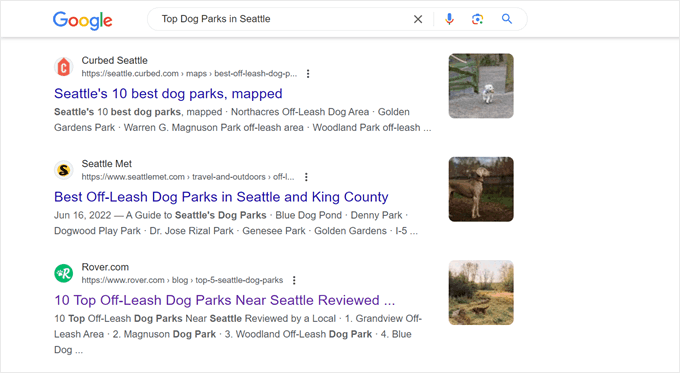
There are many benefits to creating local content. First, it attracts potential customers who are already searching for related topics. Second, it lets you showcase your expertise and build trust with your target audience.
You can then optimize these blog posts using on-page SEO techniques like including relevant keywords in your title tags, meta descriptions, and image alt text.
This increases your chances of ranking higher in local search results when people search for those keywords.
If you use AIOSEO, then you can use the TruSEO On-Page Analysis to see whether you have used enough relevant keywords in your content, title tags, and meta descriptions for your page to rank for your target keywords.
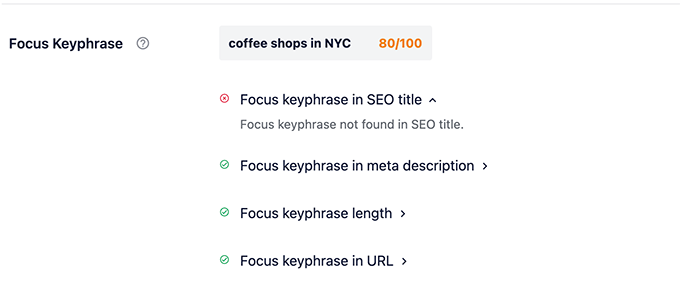
You can also use the Headline Analyzer to see if your article’s headline is enticing enough for people to click and read the content.
Here’s an example:
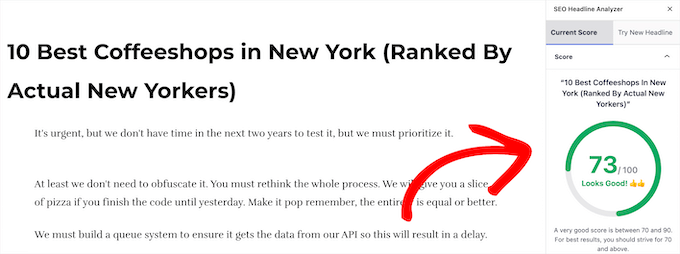
If you want to learn more about content optimization, then you can read these articles below:
6. List Your Business in Local Business Directories
Listing your company in local business directories is a very important step for local SEO. It involves registering your business with various platforms that are recognized in your local area, making it more visible online.
This visibility can lead to increased traffic to your website, higher engagement, and ultimately, more leads and sales.
Doing this can also improve your search engine rankings for local searches.
This is because directories often provide a link to your website, which acts as a form of link-building. Search engines view high-quality backlinks from relevant websites as a sign of trustworthiness.
There are general directories like Yelp and Google Business that every business should be on. That said, you should also consider your local industry associations or review platforms because they can put you in front of potential customers in your area.
Additionally, local newspapers and websites sometimes feature establishments in articles like ‘Best [Your Industry] in [Your City]’ or guides to your area. Try contacting them to see if they’d be interested in writing about your business.

If you are curious to see if there are any sites that already link to your business website, then you can use a backlink checker tool to do that.
Also, ensure that your business’s name, address, and phone number are the same across your website and all of the other directories you list in. Inconsistencies can confuse search engines and customers, potentially leading to a loss of trust and visibility.
For instance, if your business name is ‘Baker’s Delight’ on your website but ‘Bakers Delight Bakery’ on your Google Business Profile, then search engines might not recognize them as the same entity.
7. Get Customers to Leave Online Reviews
Besides getting listed on local directories or review sites, you should also encourage your customers to leave online reviews on those platforms.
Customer reviews are digital word-of-mouth recommendations. They can improve your local SEO by increasing the number of mentions of your business online. This way, search engines and other potential customers see your company as trustworthy.
At the very least, you should get customers to rate and review your business on Google. When people search for things like ‘best cafe in Seattle,’ Google often shows businesses with high review ratings in the local results.

Reviews on Yelp, Trustpilot, TripAdvisor, and other sites are valuable, too. These platforms attract people who are really interested in your industry, so your business gets seen by potential customers who are a good fit.
Social media reviews on Facebook, TikTok, or Instagram can also help your local SEO as people often look there for recommendations.
Once you have collected some customer reviews, we recommend displaying them on your website with the Smash Balloon Reviews Feed plugin.
This way, people who find your site through search will see great feedback from others, making your business seem more reliable and trustworthy.
You can check out these guides on displaying customer reviews for more information:
8. Don’t Forget About User Experience
Even with strong local SEO, a user-friendly website is key to converting visitors into customers. Here are some ways to improve your website’s experience:
Clear and easy navigation – Make it easy for visitors to find what they are looking for. A clear navigation menu with simple categories and relevant internal links helps people navigate your site quickly.
Mobile-friendly design – Most people search on their phones, so you need to ensure your website looks good and functions well on all desktop, tablet, and mobile devices.
Fast loading speeds – Nobody likes a slow website. Best practices like optimizing your images and code can significantly boost your WordPress site’s performance.
Relevant and up-to-date content – Keep your website content fresh and informative. Include valuable information about your services, pricing, and frequently asked questions (FAQs).
Strong calls to action – Tell visitors what you want them to do on your website. Clear call-to-action buttons like ‘Book Now’ or ‘Contact Us’ can boost conversions.
Technical SEO – At the very least, your website needs to have an SEO-friendly URL structure, an XML sitemap, an SSL certificate, and a proper canonical URL in its header to avoid duplicate content issues.
9. Track Your Website Performance Regularly
Just like any marketing strategy, local SEO needs progress monitoring. Tracking key website metrics helps you see how your SEO efforts are performing and identify areas for improvement.
Here are a few key metrics to track for local SEO:
Website traffic – See how many people are visiting your website and how much is coming from organic search.
Local search rankings – Monitor your rankings for relevant keywords in local searches. Tools like Google Search Console can show you where you appear in local search results.
Conversion rates – Track how many visitors take desired actions on your website, like contacting you or booking an appointment. This helps you measure the effectiveness of your website in converting visitors into customers.
User engagement – Track how visitors interact with your website. Look at metrics like bounce rate (how many people leave right away) and average time spent on site. Low engagement suggests your website content is not informative enough.
Google Analytics is a powerful tool for tracking these metrics. However, its reports are very detailed and can get confusing.
If you want to use Google Analytics for WordPress sites, then we recommend installing MonsterInsights.
This analytics plugin can integrate Google Analytics with WordPress, making it easier to monitor your website’s performance directly from your dashboard.
For example, you can track how many visitors come from Google Search, how they interact with your site, and which pages they visit most.

Furthermore, if you connect Google Analytics with Google Search Console, then you can check out the Search Console report to see your top 50 search terms right in WordPress.
This way, you won’t have to switch between platforms to check your SEO analytics.
For more information on SEO analytics, check out these guides:
WordPress Local SEO: Frequently Asked Questions
Now that we have covered some local SEO best practices, let’s answer a few frequently asked questions about the topic:
How long does local SEO take to work?
Local SEO can start showing results within a few weeks to a few months, depending on factors like the competitiveness of your local market and the quality of your SEO efforts.
For more information, check out our article on how long website SEO takes to show results.
Who should use local SEO?
Local SEO is beneficial for businesses that operate in a specific geographic area, such as restaurants, plumbers, or local retailers. It’s also suitable for businesses that want to attract customers from a certain region.
Which is better: local SEO or paid search?
Local SEO is cost-effective and builds a long-term online presence, while paid search ads can provide immediate visibility and targeted results. Ideally, it’s best to use both for a strong online presence.
Does blogging help local SEO?
Yes, blogging about relevant local content can improve your website’s rankings and establish you as an expert in your industry.
Is local SEO still relevant?
Absolutely. More and more people search online before buying locally to make informed decisions and choose the best business for their needs. Local SEO helps people find you by making your online presence more visible to your target audience.
We hope this article helped you learn about WordPress local SEO tips and tricks you can use to boost rankings. You may also be interested in our ultimate WooCommerce SEO guide and our expert pick of the best WordPress hosting providers to host your business website.
If you liked this article, then please subscribe to our YouTube Channel for WordPress video tutorials. You can also find us on Twitter and Facebook.
[ad_2]
Source link
